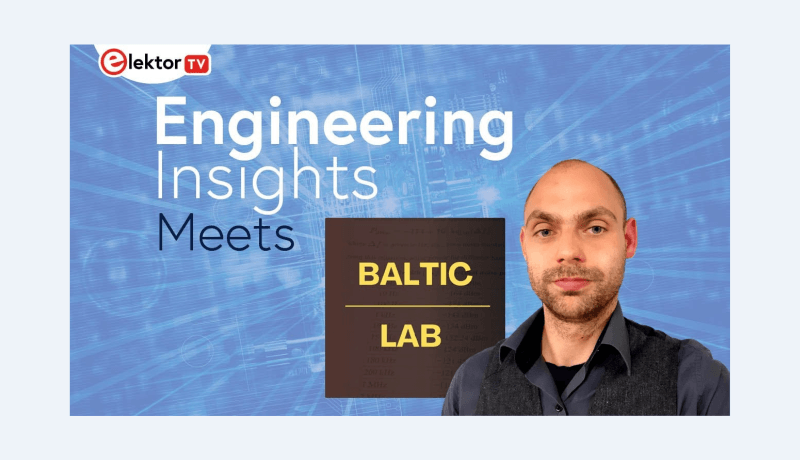Elektor Engineering Insights: Baltic Lab on RF Engineering, SDR, and More
June 05, 2024
on
on

In this episode of “Elektor Engineering Insights,” Elektor's Brian Tristam Williams interviewed Sebastian from the well-known YouTube channel Baltic Lab. Check it out below! During the discussion, they explore the fascinating field of RF and high-frequency wizardry, showcasing Sebastian's expertise and creativity.
The discussion begins without further ado with satellite gear, namely C-band and Ku-band Low-noise block downconverters (LNBs), revealing the differences between these and explaining why C-band antenna dishes are still prevalent in regions with heavy rain and high humidity. Sebastian also discusses the challenges of rain fade on Ku-band dishes and some common misconceptions about the effectiveness of larger antennas. The significant improvements in electronic analog components over the years are also showcased in by comparing the signal-to-noise ratios of LNBs from the 1990s to their modern counterparts.
Other topics discussed include the temperature dependence of semiconductors, when Sebastian changes the color of an LED using liquid nitrogen. This experiment highlights the intricate relationship between temperature and semiconductor properties in a very engaging and informative way! Furthermore, Software Defined Radio (SDR) is also greatly covered as Sebastian showcases various projects, such as picking up ultrasonic audio using a high-end SDR receiver and demonstrating SDR's versatility in modern applications. Finally, his Arduino-based audio processing projects are particularly noteworthy, including creating a digital signal processing effect for a guitar using the Arduino Giga R1 and implementing some digital effects, such as tremolo effect. All in all, this video featuring Baltic Lab’s creator is packed with fascinating technical content that you won't want to miss. Check it out below:
The discussion begins without further ado with satellite gear, namely C-band and Ku-band Low-noise block downconverters (LNBs), revealing the differences between these and explaining why C-band antenna dishes are still prevalent in regions with heavy rain and high humidity. Sebastian also discusses the challenges of rain fade on Ku-band dishes and some common misconceptions about the effectiveness of larger antennas. The significant improvements in electronic analog components over the years are also showcased in by comparing the signal-to-noise ratios of LNBs from the 1990s to their modern counterparts.
Subscribe
Tag alert: Subscribe to the tag Elektor Engineering Insights and you will receive an e-mail as soon as a new item about it is published on our website! Other topics discussed include the temperature dependence of semiconductors, when Sebastian changes the color of an LED using liquid nitrogen. This experiment highlights the intricate relationship between temperature and semiconductor properties in a very engaging and informative way! Furthermore, Software Defined Radio (SDR) is also greatly covered as Sebastian showcases various projects, such as picking up ultrasonic audio using a high-end SDR receiver and demonstrating SDR's versatility in modern applications. Finally, his Arduino-based audio processing projects are particularly noteworthy, including creating a digital signal processing effect for a guitar using the Arduino Giga R1 and implementing some digital effects, such as tremolo effect. All in all, this video featuring Baltic Lab’s creator is packed with fascinating technical content that you won't want to miss. Check it out below:
Explore More!
Want to learn more about RF, software-defined radio (SDR), or electronics in general? Check out all the educational videos and tap into the knowledge of experts on our Elektor YouTube channel and our Elektor Industry YouTube channel. Subscribe to Elektor's newsletter to receive a regular flow of expert tech knowledge and interesting perspectives. Subscribe
Tag alert: Subscribe to the tag Wireless & Communication and you will receive an e-mail as soon as a new item about it is published on our website! Read full article
Hide full article



Discussion (0 comments)